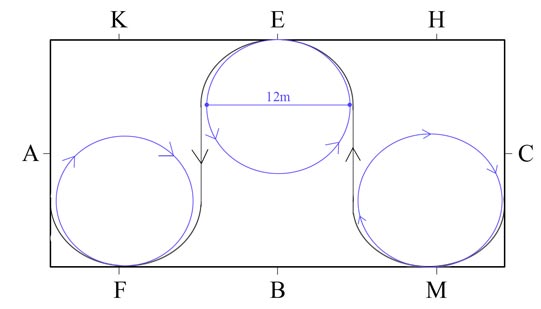More often than not I get riders asking me to run through their dressage tests with them a day or two before a show or event. Sometimes, I notice little things that can be improved with basic schooling exercises which can add a a couple of extra marks on a score sheet.
It’s important to practice your test as a whole of course, but for me, it’s more important to practice movements and transitions at home so when you put the test together, it flows from movement to movement.
I’m by no means a dressage diva, but over the years I’ve learned to ride my tests a little more tactfully with Miss G and have seen my fair share of bad habits that definitely cost a mark or two. So here are some ideas for your next center line adventure!
1 Center Line: Enter at ‘A’ knowing your horse’s preferred diagonal
Some horses are happy on both but others have a preferred diagonal. If you’re riding your test in rising trot, enter at A on the preferred diagonal regardless of whether you are tracking left or right. For me, this helps keep my horse relaxed and makes riding straight easier for both her and me.
During your test, you can change back onto the correct diagonal as you come off the center line as long as you’re confident you can maintain the rhythm and balance.

To do this, practice changing your diagonal on a straight line. Try to feel if there is any difference between the two. This is something I do while hacking regularly. The aim here is to be able to change your diagonal with out any change in rhythm or loss of balance.
To focus the exercise try it first by changing every 10 strides. If you feel no change in rhythm, reduce the number of strides between changes. Have some fun with it and see what you can do!
2 Half Halts – Playing with transitions within the gait
What is a half-halt? Well, it’s not a “thing” as I once attempted to explain to Gisela Holstein when she asked me for a definition. “A half-halt is not a thing. It comes from within you,” she replied.
And that is the truth. A half halt is an aid we use to re-balance the horse. It has different uses, like preparing for upward or downward transitions, helping to get your horse on the bit or for collection. It’s achieved by using a combination of your leg, seat and hand aids. But it has to come from within you.
The simplest way to practice this is to play with transitions with in each gait, using your weight aid. Your weight aid, in my opinion, is the most important and it vital in riding a correct and effective half-halt.
To keep this simple, start by riding your horse forward in walk. Keep an even contact, relax through your body. Soften your lower back back and allow your hips to swing with the movement of the horse, riding forward into a 4 beat rhythm.
Now, try to slow the walk by sitting a little deeper (allowing your leg to remain long) and slightly tensing your seat bones.
If your horse stops or slows down, great! It means you’ve used your weight aid. If not, keep playing with it and exaggerating the adjustment to your weight until you get a reaction. (If your horse does not understand, try using a little rein and reducing the amount of rein used as your horse begins to understand.)
Now try it in trot. Sit taller, riding forward, rolling your hips forward and back, landing center in the saddle. Ride forward for a few strides, and then simple slow down your rising, controlling your own body and weight.
When your horse reacts and slows down, be prepared to ride forward again. Aim to reduce the amount of time between the “slowing down” and the “riding forward.” This will help with the application of your aids, get your horse more responsive to you and fine tune your half-halt.
Now challenge yourself to ride your half-halts at specific markers. You can practice this in the school, or while hacking and in walk, trot and canter. Practice makes perfect for your transitions in your dressage test!
(To know more, this is a great article by Faith Meredith on Understanding Weight Aids, where she explains the importance of an “independent seat” and how the application of the weight aid can influence the horse.)
3 Use 10 meter circles to help with your turns and corners
I view the turn off and on to the centre line and corners of the arena as a quarter turn of a 10 meter circle. (Mathematically, that’s probably incorrect, but it helps me visualize what I’m riding).
Keeping balance and rhythm is very important, as we all know, so start by riding a 3 loop serpentine, focusing on maintaining the rhythm through each turn. As you ride it, say to your self: Half circle – straight – half circle – straight – half circle – straight.
Now make it a little more more difficult and add a circle into each loop. This, again, is to test your ability to maintain the rhythm and balance. It also makes you think ahead, as there is something always about to happen – the same as in your dressage test!

Challenge yourself and your horse by moving onto a 4 loop serpentine. Break your arena up into 4 sections. You can use placing poles across the center line to help with judging the size of your loops.
When you feel comfortable riding your loops, add 10 meter circles into each loop. This will be a challenge, so be prepared. Use the half halts you practiced above to balance your trot, remembering to create the bend on the inside and support your horse with your outside aids.
Once you and your horse feel comfortable with ten meter circles in your serpentine, practice riding 10 meter circles in the corners of your arena. Then, using your 10 meter circle, practice riding onto your center line just as you would as you come off your serpentine loop.
For your corners, rather than thinking about riding into, look at them as part of a circle. Push your horse into the corner with your inside leg and ride out of them onto the center line – the same way you would as you finish the bend of a serpentine onto the straight line.
4 Cantering straight lines
How often do you practice cantering a straight line off the outside track? No, showjumping practice doesn’t fully count!
Riding a straight line in canter off the outside track, while maintaining the connection and outline, can actually be a struggle for some. For me, it’s something I have to do regularly as my mare likes to swing her quarters to the inside on the right rein.

Just as you would practice center lines and straightness on the 3 quarter line of the school, challenge yourself to ride a straight line in canter. Maintaining an outline and riding forward.
This has helped me be more confident in maintaining straightness in our canter down the long side of the dressage arena whilst maintaining the forwardness.
Now, using specific makers, try using what you’ve practiced for your half -halts and weight aids to ride downward and upward transitions to and from canter, on the straight line.
5 Change the scenery

Our horses get extremely comfortable at home – as do we! So change the scenery often. School while hacking and ride out in the field. This will help you cope with any changes in behavior when you go to a show or event.
Use your imagination by picking natural markers and aim to ride your shapes or transitions around them. This will help with your depth perception and your peripheral vision, which you need to ride around a dressage arena without looking like a lost soul!
Dressage is easy. SAID NO ONE EVER!
Many people struggle with the motivation to school their horses on the flat. Some find it boring while others struggle to come up with a routine which they find beneficial or rewarding. Myself included.
The end of my most recent test had a 20 meter circle in canter at E, transition to trot at K, center line at A and halt at X, which was a nice easy test. However, those 5 movements all came very quickly. Using the 5 tips above challenged us and made us focus a little harder in our preparation. When it came to putting the test together, it improved the fluidity of the test, scoring 7.5s, 8s and a 9.
So try to think outside the box a little and stay away from your normal 20 meter circles for a while. Try to use your imagination and challenge yourself. Make your practice about aiming for accuracy rather than perfection, and hopefully you’ll see an improvement in your marks!


All good suggestions. I think that practicing straight lines is one I do often and I find I need it!
LikeLike